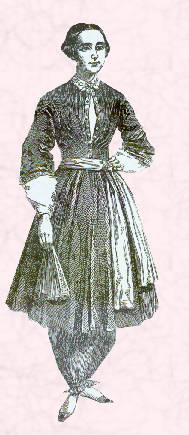A 'Westworld' Star's Outfit at the Golden Globes Is a Feminist Tradition

By:
You probably know by now that Westworld star Evan Rachel Wood made a bold statement for young girls on the "Golden Globes" red carpet by wearing a pantsuit.
 Getty Images / George Pimentel - gettyimages.com
Getty Images / George Pimentel - gettyimages.com
However, you may not know that pants have been used to protest gender inequality and support female independence throughout women's history.
"Especially during periods in which skirts were more elaborate than they are today, pants literally freed women to move," wrote Time's Katy Steinmetz last year. "Outfits containing pants were often associated with better opportunities—ones only afforded to men at the time—too."
On Sunday, Wood told reporters that she wore a pantsuit on the red carpet to tell women and young girls that dresses are "not a requirement."
Society often places restrictions on what women and girls are allowed to wear, and guidelines concerning the appropriate (or inappropriate) nature of women's clothing are consistently a topic of discussion. However, restrictions on women's clothing is not new and neither is wearing pants to protest them.
Men restricted women from wearing pants in ancient times.  Flickr/George Rex - flic.kr
Flickr/George Rex - flic.kr
The first clothing humans wore thousands of years ago was basically the same for both women and men. Nomads needed pants to ride horses long distances.
“We’re talking about small tribes of horse people who are constantly on the move,” Stanford classics research scholar Adrienne Mayor told Time last year. “It just makes sense to make sure that everyone in your group can defend themselves and handle weapons and ride.”
However, in the time of Ancient Greeks, gender roles were more defined and men stopped letting women wear pants.
“It was a sign of luxury to not allow their women to do work, or do the same things as men” said Mayor to Time.
Pants eventually became a key element of women's independence.
Although less for activism and more for practicality, frontier women in the old American West wore pants, sometimes illegally.
"The West was no place for long skirts: it was either muddy or dusty and skirts were a hindrance while doing the physical labor that frontier life required," Kathleen Cooper wrote in her western history of pants. "City records show that a 'Marie Susie' lobbied the Board of Aldermen for the right to wear pants in Gold Rush-era San Francisco, saying that she had worn 'masculine habiliments' for twenty years and wished to be protected against arrest for doing so."
.jpg?auto=format&crop=faces&fit=crop&q=60&w=736&ixlib=js-1.1.0) Wikimedia Commons - wikimedia.org
Wikimedia Commons - wikimedia.org
Women's rights activists in the 19th Century became interested in "dress reform."
Amelia Bloomer started the first newspaper for women in 1849 called The Lily, according to the National Park Service. Through her writing in the New York based newspaper, she advocated that women wear a "bloomer costume," which was a pants and tunic outfit.
 Wikimedia Commons - wikimedia.org
Wikimedia Commons - wikimedia.org
“I stood amazed at the furor I had unwittingly caused,” Bloomer reportedly said. However other women who felt restricted by the gender expectations of the time loved the outfit.
“As soon as it became known that I was wearing the new dress, letters came pouring in upon me by the hundreds from women all over the country making inquiries about the dress and asking for patterns – showing how ready and anxious women were to throw off the burden of long, heavy skirts," she said.
Harriet Tubman, the famous abolitionist who freed hundreds of slaves after her own escape, also may have worn pants during the Combahee River raid.
 Wikimedia Commons - wikimedia.org
Wikimedia Commons - wikimedia.org
More than 100 years later in 1993, female senators were still not allowed to wear pants on the Senate floor. To protest this rule, recently retired Sen. Barbara Mikulski (D- Md.) along with other female senators and staffers, simply wore pants to work until the rule changed.
"A silly rule was struck down and one of the prime symbols of gender inequity was removed," The Washington Post's Robin Givhan wrote.
